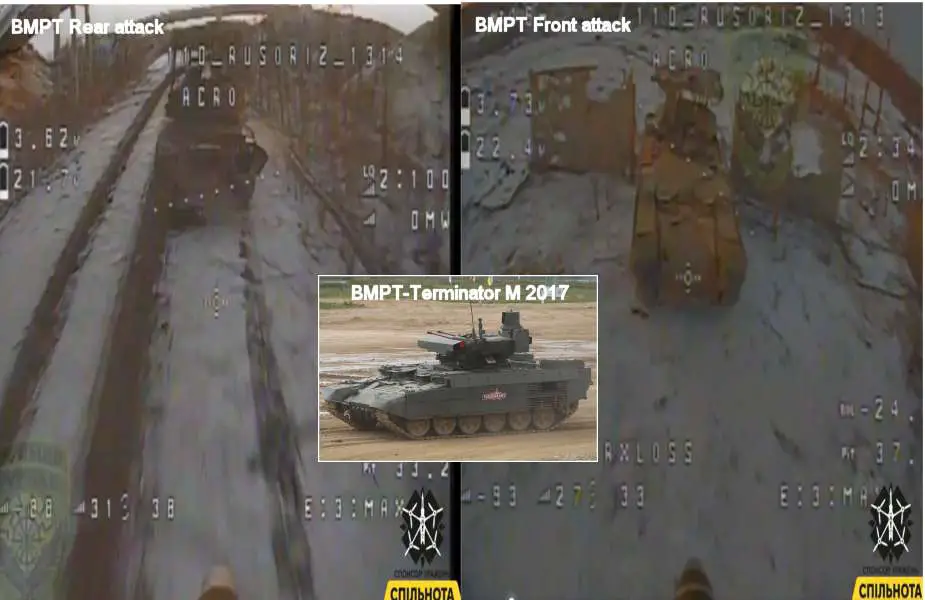According to a video released on September 27, 2023, by the 110th Ukrainian Brigade, Ukrainian soldiers achieved a significant feat by destroying a second Russian BMP-T Terminator Model 2017 Fire Support Combat Vehicle in the Avdiivka sector, Eastern Ukraine, using FPV (First Person View) drones. As seen in the footage, the BMP-T Terminator was hit consecutively by two loitering munitions equipped with 73 mm RPG rockets. The second drone proved to be the decisive strike, hitting the Terminator's engine compartment at the rear of the vehicle.
Follow Army Recognition on Google News at this link

Ukrainian loitering munitions successfully destroyed a second confirmed BMPT-Terminator Model 2017 near Avdiivka. (Picture source: Ukrainian MoD)
The BMP-T Model 2017 is distinguished not only by its role on the battlefield but also by its exceptional firepower. This Russian combat vehicle, deployed in Ukraine, is designed to provide intense fire support, particularly in urban combat scenarios, which is a key factor in the concern it raises among Ukrainian forces.
The Terminator's extraordinary firepower comes from its diverse and heavy armament. It is equipped with two 30mm automatic cannons, four guided missiles from the Ataka-T family, a 7.62mm coaxial machine gun, and two 30mm AG-17D automatic grenade launchers. This combination of weapons allows the Terminator to effectively engage a wide range of targets, from infantry to armored vehicles.
This remarkable firepower, coupled with its strong armor and mobility akin to a main battle tank, makes the BMPT a formidable presence in urban warfare. It significantly enhances the Russian forces' capabilities in close combat situations, making it a challenging opponent to counter. Additionally, the Terminator's rarity and its influential role in combat render it a high-value target for Ukrainian forces. Its destruction or capture would represent not only a tactical loss for the Russian forces but also a strategic and moral victory for the Ukrainians.
The targeted fire support armored vehicle, the BMP-T Model 2017, is a sophisticated blend of the original BMP-T/Terminator 1 and the advanced BMP-T72/Terminator 2. Manufactured by Uralvagonzavod, a leading Russian tank producer, the vehicle is designed to enhance the firepower and support capabilities of tank and motorized rifle units. Equipped with a 1,000-horsepower multifuel diesel engine, this model is one of the most advanced in the Russian arsenal, boasting immense firepower and a formidable weapons suite, including two 30mm 2A42 guns, a PKTM 7.62mm machine gun, and Ataka-T anti-tank guided missile launchers.
The FPV (First Person View) drones played a crucial role in this operation. These drones are equipped with real-time video feeds, allowing operators to identify and engage targets precisely. Their loitering capability enables them to hover over the battlefield, waiting for the optimal moment to strike. By utilizing FPV drones, Ukrainian forces were able to locate and neutralize the Terminator with minimal risk to their troops.
One of the notable advantages of FPV drones is their cost-effectiveness in engaging a wide range of targets, including tanks, armored vehicles, aircraft, and naval assets, some of which are valued at tens of millions of dollars. Civilian-grade FPV drones, typically priced between $500 and $1,000, can be equipped with basic munitions such as RPG-7 rockets, which cost between $100 to $500 each. Medium-sized drones, like the Russian Lancet, come at a relatively affordable cost of approximately 3 million roubles, equivalent to around $35,000. Even heavier drones armed with advanced missiles like the UK's Hydra 400 remain cost-effective compared to the high price tag of advanced attack helicopters like the Russian Ka-52, which can exceed $16 million.
Despite their effectiveness, several challenges persist in the extended use of FPV drones by Ukraine. These include a persistent shortage of drones, which has led to crowdfunding campaigns to finance the acquisition of additional units. Local terrain conditions can also impact the clarity of signals between the drone and the operator, necessitating meticulous mission planning to ensure effective communication and control. The allocation of limited resources presents a dilemma for commanders of the front units, who must carefully weigh the choice between acquiring pickup trucks or drones for reconnaissance missions.
For these reasons, the growth in Ukraine's drone manufacturing industry has been nothing short of remarkable. Just a year ago, the country had only seven drone manufacturers. Now, that number has ballooned to at least 80 companies actively engaged in drone production. This surge is a direct response to the increasing demand and strategic importance of drones in modern warfare. Mykhailo Fedorov, Ukraine's Minister of Digital Transformation, has reported an astounding 100-fold increase in drone production in 2023 compared to 2022. The upward trajectory is expected to continue, with projections indicating that production levels in 2023 could reach 120 to 140 times higher than those of the previous year. This exponential growth underscores the critical role of drone technology in Ukraine's defense strategy and its broader implications for warfare and surveillance globally.















